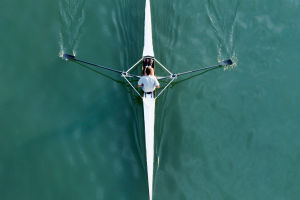For a long time, humans have dreamed of soaring through the skies like birds.
With the advancement of technology and the development of modern aviation techniques, humans have invented various aircraft, one of which is the paraglider. It quickly became popular worldwide within a few years due to its novelty, excitement, and relatively low physical demands.
Today, paragliding has hundreds of thousands of enthusiasts around the world.
Let's delve into this airborne sport that combines adventure, challenge, and leisure:
A paraglider is a combination of a parachute and a glider, essentially a high-altitude square parachute modified to perform like a glider.
So how did this combination of adventure, challenge, and leisure come about? It all started with a Frenchman. It is said that paragliding originated from a sudden idea of mountaineers in the Alpine region.
In 1978, a French mountaineer named Beaudin, living at the foot of the Alps in Chamonix, launched from a mountainside with a high-altitude square parachute and successfully flew to the bottom of the mountain. A new sport was born. In 1984, Roger Fillon from Chamonix flew from Mont Blanc, and paragliding quickly gained worldwide fame.
Flying a paraglider allows you not only to challenge nature and realize yourself but also to strengthen your will and qualities of perseverance, providing endless enjoyment for participants. Due to its unique excitement, paragliding has become widely popular in European and American countries, with over 3 million paragliders in Europe alone.
Powered paragliding, developed from paragliding, involves adding a powered propeller to the harness, weighing around 15-25kg with a thrust of 40-80kg, allowing flight times of 1-5 hours and enabling takeoff and landing on flat ground with minimal space requirements. However, it produces significant noise during flight and is relatively expensive, primarily used for training and commercial flights.
In comparison, regular paragliding is more affordable and offers more flight enjoyment. It typically takes off from hillsides, where pilots can find thermals or updrafts to spiral upwards, reaching altitudes of 2-3 kilometers. The current world record for paraglider flight duration is 24 hours, covering a straight-line distance of 350 kilometers.
Hang gliding is another form of aerial sport utilizing aerodynamics and principles of aviation to soar into the sky with small aircraft, achieving gliding, circling, and hovering. It includes forms such as paragliding, delta-winged aircraft, gliding, and ballooning, divided into powered and unpowered categories.
As early as the late 17th century, Otto Lilienthal completed over two thousand successful gliding flights. In the early 20th century, two bicycle mechanics named Wilbur and Orville Wright used their designed glider to complete successful gliding flights at Kitty Hawk in North Carolina.
Due to its ability to take off from hillsides and perform various flight maneuvers such as circling, gliding, climbing, cross-country flying, and hovering, along with its stability, maneuverability, small size, and portability (weighing only around 20-30 kilograms, easily packed into a backpack), paragliding is favored by aviation enthusiasts. Paragliding is not limited by age or physical strength, with some individuals in their 80s still enjoying the sport.
Paragliding is a unique extreme sport. The French term "parapente," derived from its roots, means "mountain parachute," illustrating its nature as a flexible-wing hang glider launched uphill against the wind. Early paragliders had glide ratios between 3:1 and 6:1, while contemporary paragliders mostly have glide ratios between 5:1 and 9:1, with some high-performance competition gliders approaching 10:1 (covering 10 meters horizontally for every 1 meter descended vertically).
World records include flying distances exceeding 300 kilometers and staying airborne for over 24 hours, reaching altitudes of several thousand meters.
As paragliders continue to explore new horizons and push the boundaries of aerial sports, one thing remains certain: the allure of flight will forever captivate the human spirit, inspiring generations to come to take to the skies and experience the exhilarating freedom of flight.


